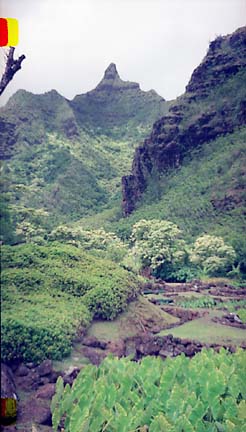


Ever Green

Lois Taylor, Star-Bulletin
The tour of Limahuli Valley begins at terraced lava fields
that were cultivated by the valley's early inhabitants.
TUCKED between steep mountains near the end of the road to Haena State Park on Kauai is Limahuli Valley, a rare piece of living Hawaiian history. Archeological evidence indicates the valley was settled by the first Polynesians to arrive in Hawaii some time around 200 A.D., chosen by them for its fertile soil, continually running stream and plentiful marine life. It is, therefore, one of the earliest settlements in Hawaii. Kauai valley
preserves the pastThe valley has been carefully restored and maintained as Limahuli Garden, one of several gardens in Hawaii and Florida managed by the National Tropical Botanical Garden. NTBG is a privately funded, nonprofit organization chartered by the U.S. Congress in 1964.
The 17 cultivated acres of Limahuli were given to NTBG in 1976 by Juliet Rice Wichman to preserve it for future generations and to show them a remnant of ancient Hawaii. Five years ago her grandson, Charles "Chipper" Wichman, gave the adjoining 985 acres at the back of the valley, called Limahuli Preserve, to NTBG. He is now the director of the garden, which is open to the public.
LIMAHULI GARDEN
Where: Haena, Kauai
Hours: 9:30 a.m. to 4 p.m. Tuesday through Friday and on Sunday
Cost: $15 for 2 to 2-1/2 hour tour with an experienced guide; $10 for self-guided tour along a 3/4-mile loop trail
Call: 1-(808)-826-1053 for reservations, required for guided tours, and information
Visitors have the choice of a self-guided tour using a skillfully written and illustrated guidebook, or of a guided tour with trained leaders. The route in either case is a walk through lava rock terraces, built by Limahuli's early inhabitants, where taro still grows. The area surrounding the taro fields is landscaped with tropical planting. Much of it is native or of Polynesian introduction, brought by early settlers from the Marquesas in their voyaging canoes. Plants introduced since Captain James Cook's arrival in the islands in 1778 are considered "modern."
"From my understanding," Chipper Wichman said, "the Polynesians were looking for an ideal place to settle. What they found here was an entire ecosystem, from the mountains to the sea, unique plants and insects and birds in an established balance. But there was nothing to support their existence, nothing to eat, so they brought necessary plants and animals in on later voyages. At first they depended upon the ocean to feed them, along with freshwater fish from Limahuli Stream."
The stream, which flows with 2 to 8 million gallons of fresh water daily, begins at the top of the valley at 3,300 feet above sea level. It drops over an 800-foot waterfall before hitting the valley floor and spilling out to sea. It provides irrigation for the taro fields and the Hawaiian definition of wealth. "Wai" means water. "Waiwai," or abundance of water, means wealth.
"When the first Hawaiians arrived here, 90 percent of the plants growing in the valley were endemic, found nowhere else on earth. They had never seen them before," Wichman said. "These plants evolved in isolation without natural predators or competition."
It is that lack of protection -- thorns or poisonous sap among other defenses, that explains why so many of our native plants are either extinct or endangered.

Taro is the most important of the Polynesian introductions. Wichman, whose degree is in horticulture, says he has learned much of what he knows about taro cultivation from the Hawaiian elders, the kupuna of Haena."I am intrigued by what the Hawaiians did with taro," he said. "It's a crop that grew 20,000 years ago in the Fertile Crescent of the Nile, and has been cultivated in China, but nowhere has the farming of taro been refined as it has by the Polynesians. Over hundreds of years, they have cultivated 100 varieties of taro. They were horticulturists and conservationists."
So the question that most visitors ask, and to which there is no sure answer, is "What happened to these early settlers?"
"It is thought that the population peaked about 100 years before Cook arrived," Wichman said. "It was already declining on Hawaii, Maui and Oahu because continual warfare took a toll on their quality of life. Things changed with Cook, who brought in alien diseases from flu to gonorrhea, to which they had no immunity. They were mowed down. In the first 70 years after Cook, 80 percent of the population died."
Limahuli has been in the hands of Wichman's family since the time of his great-great-grandfather, William Hyde Rice, who spoke Hawaiian and collected many of the legends of the valley, which are told by guides on the garden tour. But cattle roamed wild over the area for 100 years, and damaged the taro fields and ancient stone walls.
"Restoration began with my grandmother, Juliette Rice Wichman, who moved to Haena in 1946 and immersed herself in the history of the valley. Her dream was to build a garden to preserve and share the culture of the early Hawaiians," he said.
In 1997, Limahuli Garden received the American Horticulture Society's award as the best natural botanical garden in the United States. That's exactly what Chipper Wichman's grandmother had in mind.
Gardening Calendar in Do It Electric!
Send queries along with name and phone number to:
Evergreen by Lois Taylor, Honolulu Star-Bulletin, P.O. Box 3080, Honolulu 96802.
Or send e-mail to features@starbulletin.com.
Please be sure to include a phone number.
Evergreen by Lois Taylor is a regular Friday feature of the
Honolulu Star-Bulletin. © 1998 All rights reserved.